
by amie.huiam.net | Mar 17, 2023 | Adult bikes, Cycling advice & tips
If you’re looking to save money on your journey to work, or simply want to commute in a way that’s healthier for you and the environment, the ‘Cycle to Work’ scheme is a huge incentive to do so.
Read on to find out what the scheme actually is, in addition to how you can go about getting a brand-new bike so that you can travel to work in style.
What is the Cycle to Work Scheme?
This scheme is a government incentive for workers to start cycling to work. The scheme offers great savings for those looking to purchase ladies’ bikes or men’s bikes to commute on, from anywhere between 25% – 48%.
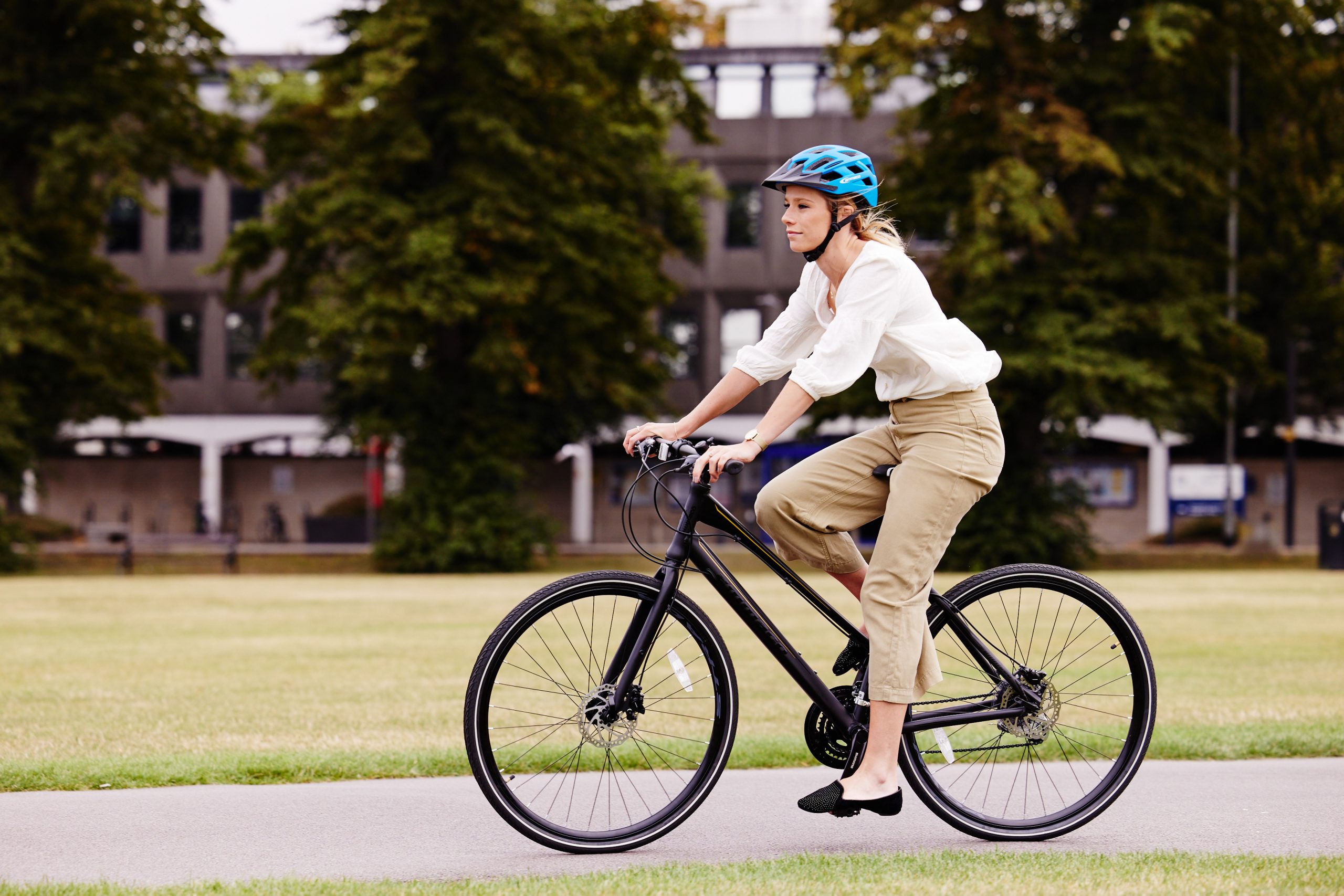
Actually, getting your bike is a rather simple process and can be easily negotiated with your employer:
- First, inform your company that you’re interested in the scheme…of course they’ll need to be providers of the scheme for you to get the benefit (but more on this later on)
- Next, you’ll need to pick out the bike you want and any accessories you need (like a helmet, lights, his-vis clothing, etc.) and work out the total using a Cycle to Work Scheme
- This will then be taken into account with your employer, which will lead to an agreement on how much the company will effectively loan you and the repayments that will be taken directly from your salary
- At the end of your term, you can either pay a small sum to own everything outright, or give your bike back to the company
‘Where does this discount come from?’ you’re probably asking. Well, this is because the company is buying the bike as a tax-free benefit. This makes the scheme a win-win for everyone involved.
It’s a win for you as you’ve got a shiny new bike to use both for getting into work and in your personal time.
It’s great for the government, as this deduction in the bike’s cost means that you’ll be more inclined to use a cleaner method of transport, cutting Co2 emissions.
And lastly, it’s a win for your company as they can provide you with this extra benefit which will help improve your motivation at work (and maybe even save on some car parking space).
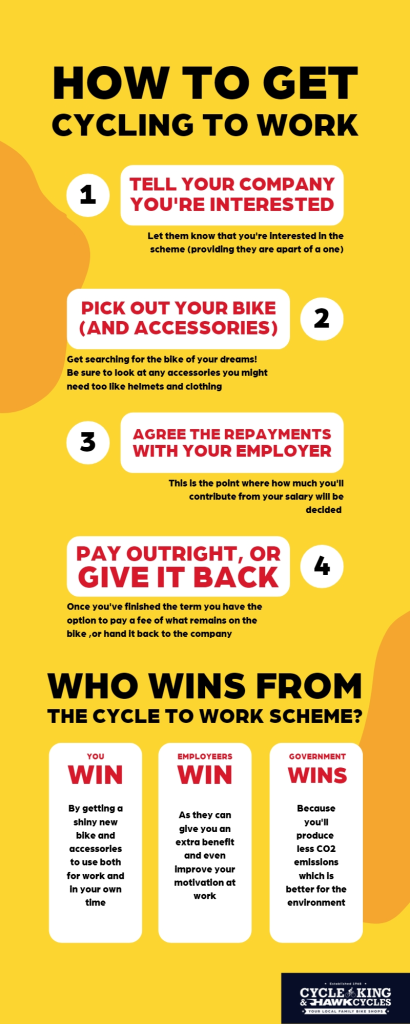
What are the benefits of cycling to work?
If you can easily travel in to work on a bike, then it is definitely an opportunity you should grab by the handlebars.
Among the plethora of benefits, we’ve boiled it down to 5 great reasons you should consider the scheme.
Improves your fitness
Getting on two wheels is a fantastic way of keeping up your fitness levels (even if you opt for a power assisted E-bike).
If your commute is 10 miles each way, for example, then you’d actually be burning around 4672 calories a week (that’s equivalent to 9 burgers!). Daily exercise can make a huge difference to your overall health.
Good for the environment
Cycling to work is not only good for you, but the planet.
You might be surprised to know that from a year’s worth of commuting 10 miles each way, you could save as much as 365kg of carbon dioxide from being released into the atmosphere by car (that’s as much as 17 trees can absorb in one year).
It’s great for your mental health
Unlike a car, bus, or train journey, cycling to your work gives you some much needed ‘me time’.
Instead of having to focus on the road, or be distracted by your phone inside squashed public transport, biking into work gives you an opportunity to absorb your surroundings.
A survey by We Are Cycling UK found that 91% of participants deemed off-road cycling to be very important to their mental health. Even if your ride into work doesn’t go into the dirt tracks, you can still appreciate the little things on your way to work and detox your mind for better mental health.
A bike can actually save you time
If you’re frequently stuck in rush hour traffic jams, or even long train delays, you’ll find that these issues will melt away when you commute by bike.
Being more agile (and having the option to skip traffic by walking on the pavement with your bike) makes waiting around a thing of the past, meaning you can crack on with your day.

Improve your sleep quality
All that extra exercise is bound to tire you out during the day, making it a bit easier for you to fall asleep when your bed is calling.
Not only will you feel more refreshed in the morning, but commuting into work by bike is likely to help make your sleeping pattern far more regular.
What Cycle to work schemes are available?
There are a few schemes in which you can go with to get the bike of your dreams, but this is mostly dependant on your employer.
It’s a very simple process for both employer and employee to get cycling. All it takes is for the employer to register, and for both parties to sign the hire agreement in order to get the bike and accessories you need.
Available to any employer, and all it takes is a simple form to give everyone in the office or site a choice to cycle into work.
NHS’ Cycle to work scheme
This is specific to NHS staff; in that you’d need to contact your NHS Employers HR department to get the ball rolling here.
Am I eligible for the Cycle to work scheme?
There aren’t any specific requirements for employees to be eligible for any of the schemes we’ve mentioned. However, what makes you eligible is whether your employer is open to becoming a part of the schemes.
A lot of companies do, however, and it’s as simple as asking if this is something they carry out for their employees. For the employer looking to get more people on bikes, it’s a good starting point to ask employees if they would be interested, making everyone’s commute greener and a bit more enjoyable.
- It often depends on your employer, you’ll have to get talking to them to see if this is something they do
- Unfortunately, some will not have this as an option but hopefully where you work can help you get the ball rolling with getting a brand-new bike
We hope that after reading this blog, you’re now inspired to get involved with the scheme and make a difference to both the environment and your own health. It is probably a lot simpler than you thought, so there’s no excuse for you to not get cycling!
What if your employer isn’t in a scheme?
Even if your employer isn’t apart of any schemes, it doesn’t mean that you can’t get a new bike.
Buy on Finance
You also have the option to split payments over a time period, just without the taxable benefit.
We offer Klarna finance which is a very affordable way to pay for a brand-new bike and accessories in 3 payments over 3 months.
As a partnered brand with the schemes we’ve mentioned, you can easily browse our hybrid bike range or visit one of our stores today to see which bikes and accessories would suit you best.
For the best commuter experience, we recommend our range of folding electric bikes – compact enough to go under your desk yet powerful enough to get you to work and back. Simply view our mens’ and womens’ bike range and see for yourself how a bike could really change your working life.
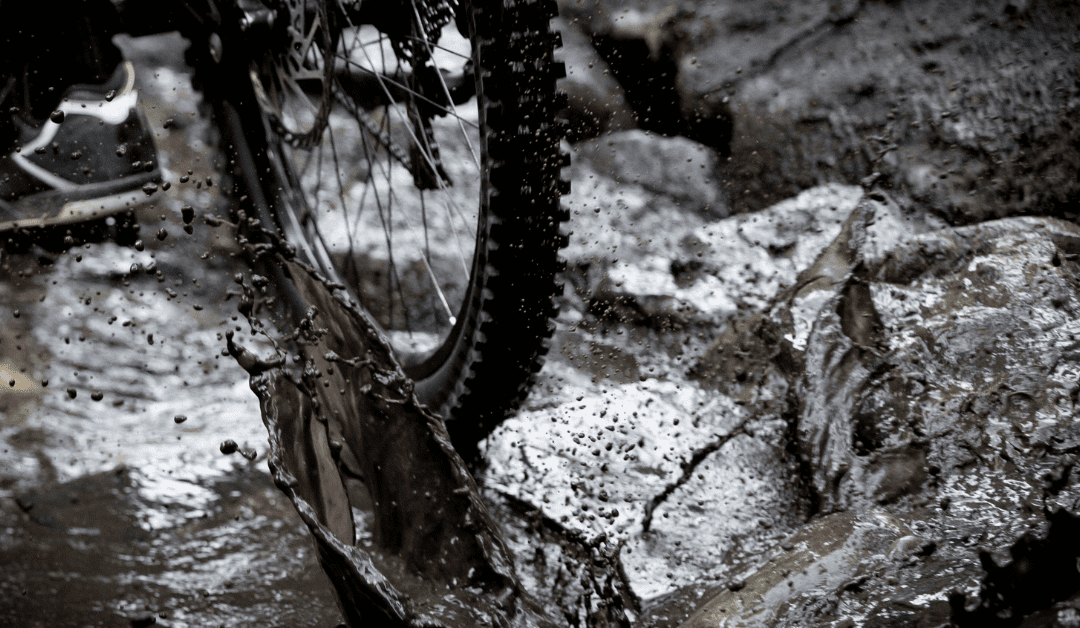
by amie.huiam.net | Jan 26, 2023 | Cycling advice & tips
Winter can be a tricky season for cyclists. The short days and cold weather often means that cyclists are out on the roads when visibility is low, and the roads are more dangerous. Lack of preparation when cycling increases your chances of being involved in an accident.
In this blog, we’ll share with you some tips on how to stay safe when out cycling this winter and some products that we recommend to any and every cyclist.
The Importance of Visibility
Making sure that you’re visible is essential for cyclists to stay safe…
It helps ensure that you are seen by motorists, pedestrians and other cyclists when riding in low-light conditions. Furthermore, wearing bright colours or reflective materials helps to make sure that your movements on the road are more visible. This could be especially beneficial if there are any obstacles in your path that may not be visible to drivers until it is too late.
It’s also worth noting that the UK’s highway code legislation requires cyclists over a certain age to wear a reflective vest or similar item while riding their bikes at night time. You are also legally obliged to have front and rear lights and reflectors attached when riding in low-light conditions.
Even if you are cycling during the day, or as it begins to turn to dusk, it’s still a good idea to wear something bright to draw attention to yourself and help to prevent accidents on the road.
Essential reflective accessories
We recommend that you equip yourself with these accessories when using your bike in low light.
Bike Lights
Good quality front and rear bike lights are essential for making your presence known on the roads. In the UK, your front lights must be white and rear lights red to be in compliance with legislation.
Flashing lights are permitted, but it is recommended that cyclists who are riding in areas without street lighting use a steady front lamp to improve their visibility. At Cycle King & Hawk Cycles, we have a great selection of bike lights which will help you stay visible while cycling in low-light conditions. Below are a few of our top recommendations.
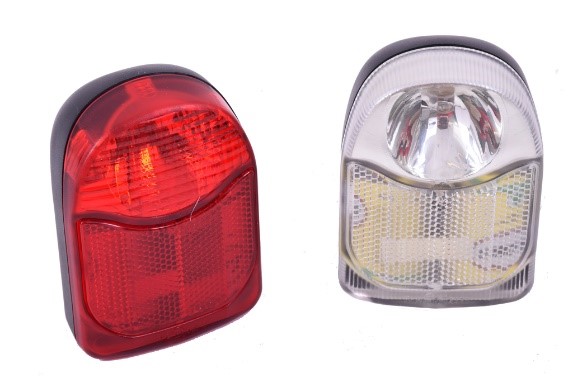

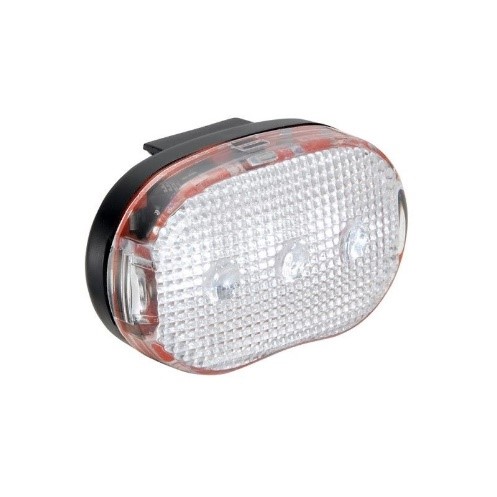
Reflectors
Reflectors are a very handy addition to any bike, as they are relatively easy to install and don’t require any external power source to do their job.
Plenty of the bikes we stock come ready to ride with reflectors fitted, but can be easily upgraded for better peace of mind when cycling.
What Should You Wear When Cycling in The Winter?
There are a few different types of high-visibility clothing available on the market today, designed to help keep you safe.
From simple yellow vests with reflective strips to more elaborate designs with fluorescent patterns, there’s something practical for every cyclist. Not only does reflective clothing help you stay safe, but also gives you an opportunity to show off your style!
Wear a Helmet Light
Helmet lights are a great way of increasing your own visibility and improving your vision of what’s ahead on the road. Front lights throw a bright beam onto the road ahead which helps you spot obstacles such as potholes, and rear lights add an extra bit of visibility for the benefit of other road users, perfect for staying safe while commuting at night or during wintery conditions.
You can even equip your helmet with a fluorescent cover, or alternatively, you could invest in a high-visibility helmet to improve the safety of your bike ride. These small changes all add to make your journey that bit safer during the winter.
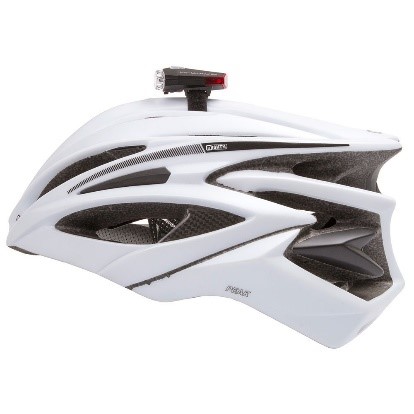
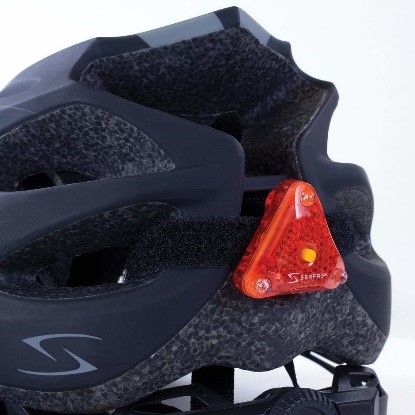
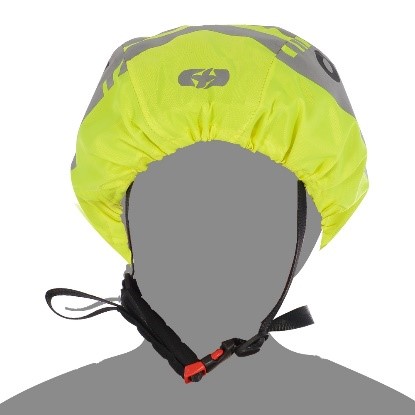
Invest in Quality Clothing
It’s also important to invest in quality clothing if you plan to cycle throughout the winter season. Make sure that your clothing is waterproof and windproof so that it keeps you warm and dry during wet weather conditions or cold temperatures. We offer an extensive range of protective cycling clothing and accessories which will help keep you comfortable even when temperatures drop below zero!
Hi-Vis Vests
Vests are probably the most common type of high-visibility clothing worn by cyclists; they come in various colours and sizes. A vest is easily compactable, making it a lightweight addition to a commuter’s work bag without comprising space and are very affordable. Click the images to take you straight to our recommended vests.

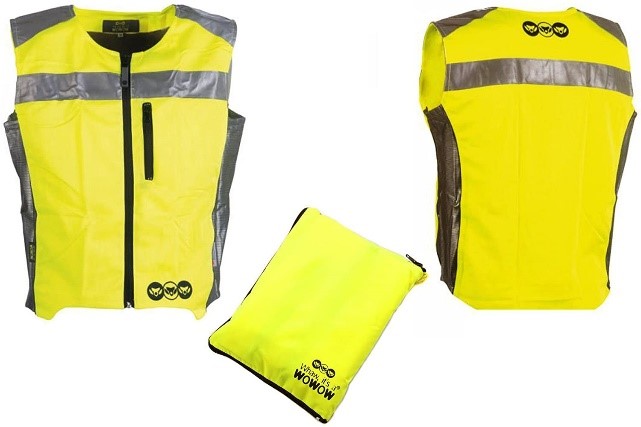
Fluorescent Jackets
Fluorescent jackets are also available, which can be equipped with fleece insulation and additional zip pockets. If you need something that is sure to keep you warm, then investing in a fleece is certainly the way to go.

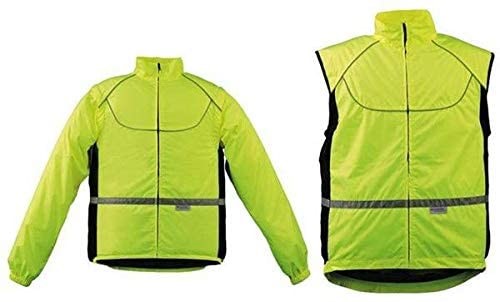
Cycling safety should always be a priority, especially during the winter months you are more likely to encounter dangerous cycling conditions. By following these simple tips, you can ensure that your bike rides remain safe regardless of the weather conditions this winter season!
If you’re looking for quality hi-vis cycling clothing or bike lights, make sure to check out our full range here at Cycle King & Hawk Cycles!
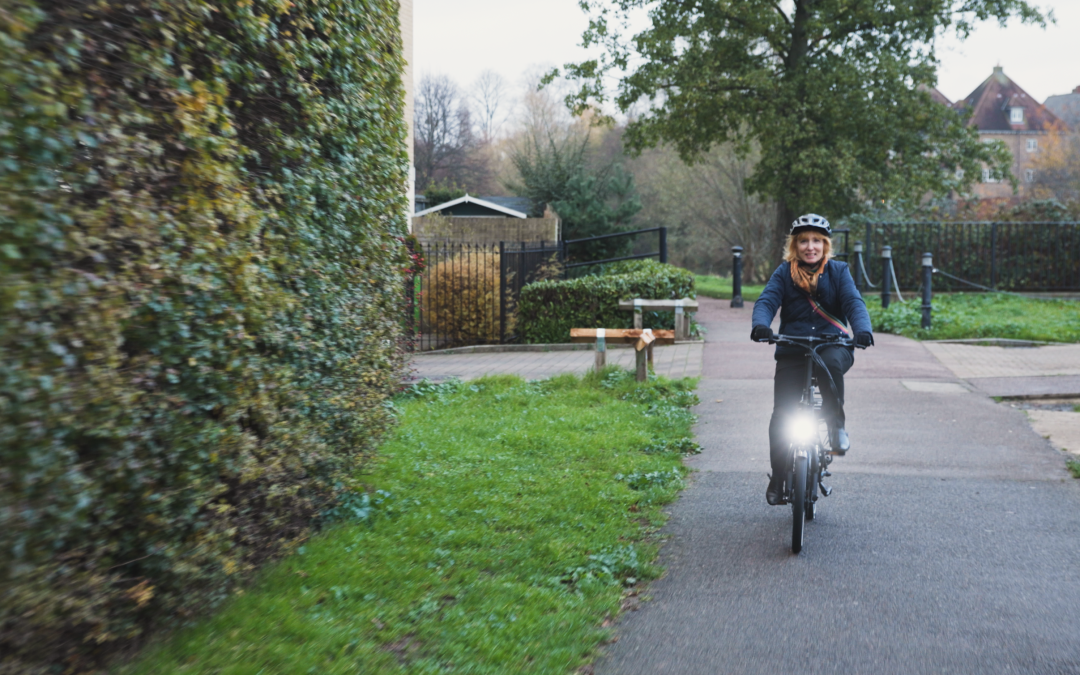
by amie.huiam.net | Dec 23, 2022 | Adult bikes, Cycling advice & tips
In recent years, electric bikes have become an increasingly popular choice for our customers both in-store and online. We see people of all ages investing in these kinds of bikes, as they combine all the traditional benefits with the power of an electric motor to help you ride further and faster.
If you’re thinking about buying an electric bike, there are definitely a few things you should consider before making your purchase. From the battery size you need, to safety concerns that you may have around an ebike, this guide will walk you through the key features you should look for when choosing an ebike.
There are many advantages to owning an electric bike over ordinary bikes, here are our top three:
Motor assistance
If you’re out for a long ride or need to cover some hilly terrain quickly and easily, an electric bike can help get you there with less effort.
For commuters, an ebike really does help to take the strain out of your commute. After a long day at work, the power of electricity means a lot less strain on your legs, making what would be a strenuous ride on a standard bike far easier for the journey to and from the office.
The Falcon Flo Folding Electric Bike is a great choice for commuting. With a quality 36V 7.8Ah battery that fits in the rear of the frame and can be easily removed for charging, but securely locks in place when out and about. This folding bike can achieve up to 60km per charge!

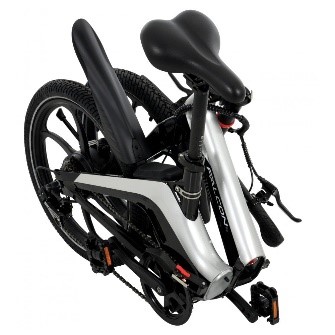
Environmentally friendly
Additionally, electric bikes are more environmentally friendly than other forms of motorised transportation since they don’t produce emissions.
The majority of journeys (71% in England) made are under five miles, but cycling only accounts for less than 2% of all journeys. Imagine the money you could save if those short drives to pick up a few items at the shops or dropping the kids off at school were on an ebike.
Check out the Elswick 26 Inch Wheel Electric Bike, based on a classic Dutch sit-up riding position and with a handy basket, it has a powerful 250W BAFANG rear hub motor, 3 levels of power assistance and a walk-assist mode which is handing for walking the kids to school and powering your way home!
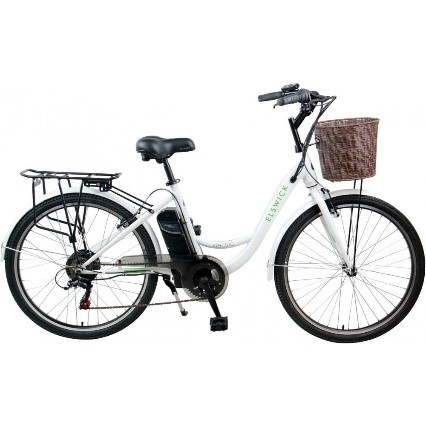
But if you are concerned that e-cycling is cheating, it’s not! Many studies have shown that e-bikers get plenty of very beneficial aerobic exercise. The vast majority of e-bikes have power level settings on the handlebar controls that let you dial down the power if you want more exercise or turn it up if in need of more assistance.
Feel young again with an ebike!
This is something that Adrian at our Benfleet store knows very well,
“An electric bike can extend your cycling career considerably. We have one gentleman who used to cycle around Epping Forest as a child, and now being in his 60s, his electric bike has helped him re-live all those nostalgic routes again.”
That extra push an electric bike can provide really does make all the difference to a person’s ride.
The Lectro EM-300 range of stylish electric mountain bikes are very reliable, and great for any adventurous cyclist who wants to keep powering away on and off-road. Their lightweight alloy frame supports an external down tube battery, alloy suspension forks with adjustable lock out and high speed brushless 250-Watt motor!
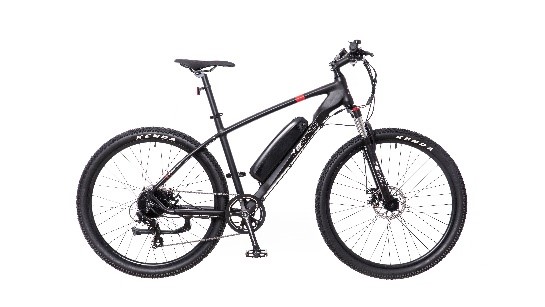
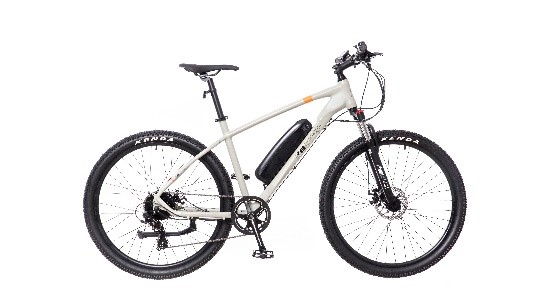
Efficiency & Safety Concerns
There are several factors to consider around ebikes which may impact your safety. It’s essential that you take your time to carefully evaluate if the product you like has these as standard.
Is the bike built well?
An electric bike should be designed with quality components that will last longer and provide a smoother ride. This means not only looking into the battery size (more on this in a minute), but the gears, wheels, chainset, and digital display to use the electric functions, to name a few.
Doing this is sure to make your bike last that bit longer, as not researching properly could lead to disappointment in years to come.
Are the brakes good enough?
Good brakes will ensure that your bike stops quickly when necessary.
With their heavier frames due to the motor and battery integration, any e-bike worth its salt will have disc brakes to stop the combined weight of you and the bike. This should be something you keep on the lookout for, as reduced stopping power can lead to accidents.
Does it have good lighting?
Finally, make sure that your bike has sufficient lighting so that you can stay safe in low-light conditions or at night.
There are plenty of electric bikes which come with front and rear lights which are battery-powered, making them a perfect choice for commuters on winter nights
We find that people really enjoy using the Chill-e Low Step Folding Electric Bike for going to and from work. The power assist is a dream after a long day’s work and the lighting is superb for when the nights begin to pull in.

Battery Life & Charging
The battery life of an electric bike depends on the type of battery used, as well as how often it is used. Look for batteries that are designed to last for at least 1–2 years with proper care and maintenance; some models may even last up to 5 years with minimal wear and tear!
Additionally, make sure that your battery is easy to charge. Most batteries can be recharged via wall outlets or USB ports in just a few hours—so you don’t have to spend too much time waiting for it to charge up again before heading out on your next adventure!
One bike that we recommend for a high mileage is the Ampere X-Trail 29 Inch Mountain Bike. The choice of the 14Ah battery option boosts the range to a very impressive 55 miles on a full charge, and takes 6 hours to recharge from empty.

Riding Electric Bikes in the United Kingdom
When getting an electric bike, you must understand the legislation around their proper use before actually riding. There are certain laws regarding where and how you can use them; for example:
You must be 14+ to ride an ebike
Only those aged 14 or over may legally ride an e-bike on public roads or cycle paths (with speed limits set at 15mph). Children below this age should not be out in public on an electrically assisted peddle cycle (EAPC).
It must be registered, taxed, and insured
You won’t need to have a specific licence to ride an electric bike, but since it is classed as an electrically assisted vehicle, you’ll need all the official documentation for it to be road legal.
There are plenty of insurance providers who you can visit, such as Money Super Market where you can get a quote for the bike you’ve got your eye on buying.
Always wear a helmet
Helmets must be worn at all times regardless of age group or location. This is no different for a non-powered bike, but considering the speed an electric bike can travel, it’s essential that you protect yourself.
We always recommend wearing Hi-Viz clothing too. And if you’re riding in low light remember that reflective attachments will help you be seen and safe!
For more information on e-bike regulations in the UK, you can visit our resources page, as well as the information available on the gov.uk website.
If you’re looking for an efficient way to get around town without having to rely on public transport or drive a car, then an electric bike might be just what you need!
Whether it’s cruising around town leisurely or taking on tougher terrain quicker than ever before – check out Cycle King & Hawk Cycles’ full range of adult e-bikes available here, we’ve got something perfect for everyone!
With this guide under your belt – what are you waiting for?

by amie.huiam.net | Dec 15, 2022 | Cycling advice & tips
If you’re a keen cyclist who loves to ride their bike in new places, a bike rack is most likely going to be a solid investment. Their purpose is to make your life easier when transporting your bike from A to B, so that you can enjoy new surroundings.
Whilst picking any bike rack is all well and good, actually knowing which kind to get is another thing.
In this article, we’ll go in to detail about our 3 different types of bike racks, which include roof-mounted, rear and tow bar mounted solutions. These all have their benefits and drawbacks, and our guide aims to help you make a decision based on which is most suitable for your needs.
You might think that this isn’t an important decision, but the placement on your car can actually have quite an impact on the way you travel with your bike.
Roof-mounted bike racks
Most roof-mounted bike racks attach directly to the roof bars of your car, which is an ideal solution providing your car already has roof bars fitted. It can be costly to get roof bars retro-fitted, so rear-mounted or towbar bike racks may be a more suitable option. Some brands, such as Seasucker, offer suction based racks which are suitable for two bikes, but require you to remove the front bike wheel.
- Great for avid cyclists: Roof racks are definitely more of a permanent fitting on your car. These can be good for those who are really passionate about cycling here, there, and everywhere as installing this kind of fitting is often more long term.
- Get a clear view from behind: With bikes on top, a clear rear view mirror is guaranteed. Other racks could obstruct your rear view and be an annoyance for the driver. Roof racks thankfully don’t come with this problem, and also do not require a lighting board as the bikes do not obstruct your back number plate.
- You might have to be on the taller side: It’s true to say that roof racks are better suited to taller people. If you are vertically challenged, then this might not be the right rack for you. Keep in mind the height of your car and also the weight of the bike(s) that you plan to transport and ensure that you can lift them up properly before choosing a roof rack system for your bikes.
- Your car might be too high: A large, high car really stands out amongst the crowd, but one fatal flaw in your car’s height could be the restrictions often found on entry to car parks in natural beauty spots around the country. Designed to keep caravans and vans out, they also can be a problem when using a roof carrier for your bikes. Imagine, it’s a busy bank holiday weekend and you finally find the perfect parking space, only for the car park to have a height restriction. Whilst this might not always be the case, it’s important you understand this when making your bike rack decision.
Rear / Boot-Mounted Bike Racks
If you don’t fancy investing in a roof carrier, then maybe a rack that fits nicely on the back of your car would be better for you.
There are generally 2 types of racks that can fit the bill:
Rear/Boot mounted
This kind of rack is a great choice for a casual cyclist, or someone who is looking for a shot-term or less permanent solution…
Rear mounted racks attach on to the boot door, meaning that whilst you can carry all your bikes, your actual boot storage might be obstructed by it. We find that these kinds of racks make good buys for those looking to adventure out now and again, for their lower price point and ease of installation. Beware, a common downfall of rear-mounted racks is that bikes may rub together when tightly packed which potentially could cause some aesthetic damage. This might not be as big a deal if you are carrying your family bikes for a summer holiday, but can be more of a concern if you are carrying high value or performance bikes. You must also ensure that when bikes are mounted, your rear number plate and lights are not obstructed, making it illegal to drive.
Towbar / hitch mounted
Similar to the way a boot mounted rack works, a towbar/hitch mounted bike rack requires your vehicle to have a towbar or towball.
If you already have one installed, then this might be a good choice for you in your cycling needs as it’s quick to fit, removable, and can carry multiple bikes.
However, if you’re not up for installing a towbar (which can cost you £100’s), this might not be the option for you.
These back mounted racks come with some notable highlights:
- Easy to fold away: You’ll find that when you’re not out on your cycling odysseys, these kinds of racks can be easily compacted down, meaning you won’t have to compromise on it taking up space in your home You don’t have to be a giant to use these racks
- Ease of use, no matter your height: Since your bikes won’t be on the roof, you will be able to take your bike on and off of the rack with ease.
There are also some drawbacks:
- Your vision will likely be obstructed: Probably the greatest flaw in this kind of rack. What is attached to the back of the car will make it harder to see what is behind you whilst driving. This is more of an inconvenience on the odd occasion, but for avid enthusiasts, it’s a bigger issue which might warrant an investment in roof racks.
- You’ll likely need a lighting board: Finally, all those bikes that you’ll carry will of course obscure your number plate, meaning that you’ll most likely need another license plate, and maybe a lighting board (some racks do come with them, however).
Bike Rack compatibility
You’ll need to do your research into the product to see if the rack you are considering will actually fit your car. If in doubt, don’t hesitate to call in at one of our 23 stores where one our team can help you choose the right product. Although this might seem like an obvious point, don’t forget to come to the store in the car you want to use the rack on, as this will help our team to make recommendations.
Best Bike racks for E-bikes
If you’ve got an electric bike, then you’ll need to make sure that the rack you buy can be used to hold it.
Products like the Peruzzo Zephyr 3 Towbar E-Bike Car Rack are specially designed to carry e-bikes, with a total loading weight of 60kg, up to 3 electric bikes (or 4 standard bikes) can be safely placed onto this rack.
In addition, some E-bike racks also come with accessories to make loading easier. This rack comes equipped with a ramp, so that loading up your heavier bike is far easier, and doesn’t put a strain on your back when trying to lift.
Make sure your bike rack is road legal
When gearing up for a bike ride in a totally new place, you must set the excitement aside for a moment and think of the legalities. To stay road friendly, you must fulfil certain requirements:
If you bike/bikes obstruct your back number plate, then you absolutely must place a lighting board with your license plate on your rack. As mentioned previously, some models do come with one, but this will also be another cost if one is not already included.
Best Bike Racks for Cars 2022
As a well-established cycling retailor, we only stock bike racks that we know will work for you and your needs. In order to inspire your decision, we’ve collated some of our top picks for rear and roof mounted bike racks below.
Peruzzo Cruiser Deluxe 3 Bike Rack
This rear bike rack is really easy to fit on to most vehicles, coming fully assembled.
Straps to secure your bikes into the rack are included, and the lower straps have anti bounce technology, giving you an extra fail-safe system.
Hollywood FB3 Baja Over Spoiler 3 Bike Rack
Designed with saloon cars in mind, this kind of rack is prefect for weekend adventures and fits over most vehicles (except hatchbacks or flatbacks, of course).
You’ll be able to take up to 3 standard bikes anywhere, and like our other models, folds flat for easy storage.
Peruzzo Pure Instinct 2 Bike Towball Rack
If you’re not looking to take loads of bikes with you, then this product might be perfect for you.
This is a great rack solution, not only for standard bikes, but also e-bikes and fat bikes. The max capacity of 60kg is sure to be more than enough for your bikes and also packs away really nicely into a well compacted unit
Hollywood FT3 3 Bike Towball
This towbar rack features a solid construction, as well as anti-sway cradles to keep your bikes as secure as possible whilst on the move. In addition, the rack easily tilts back so that you won’t lose access to your boot.
Peruzzo Roma Single Bike Roof Bars
These bars have wheel holders and locking levers between the actual bike and carrier which attach to your roof rack. This kind of rack is really well suited to racing bikes, but can also fit oval down tubes between 70mm to 90mm.
At the end of the day, a bike rack is only useful if it caters to your needs. Whilst we’ve given you some very strong and reliable suggestions, it will be up to you to do some extra research to determine which is most suitable for you.
If after digesting this guide you’re still in the dark, then do feel free to come down to one of our 23 stores across the midlands and south England. Our friendly expert colleagues are sure to help you determine which back rack would be the best fit for your car.
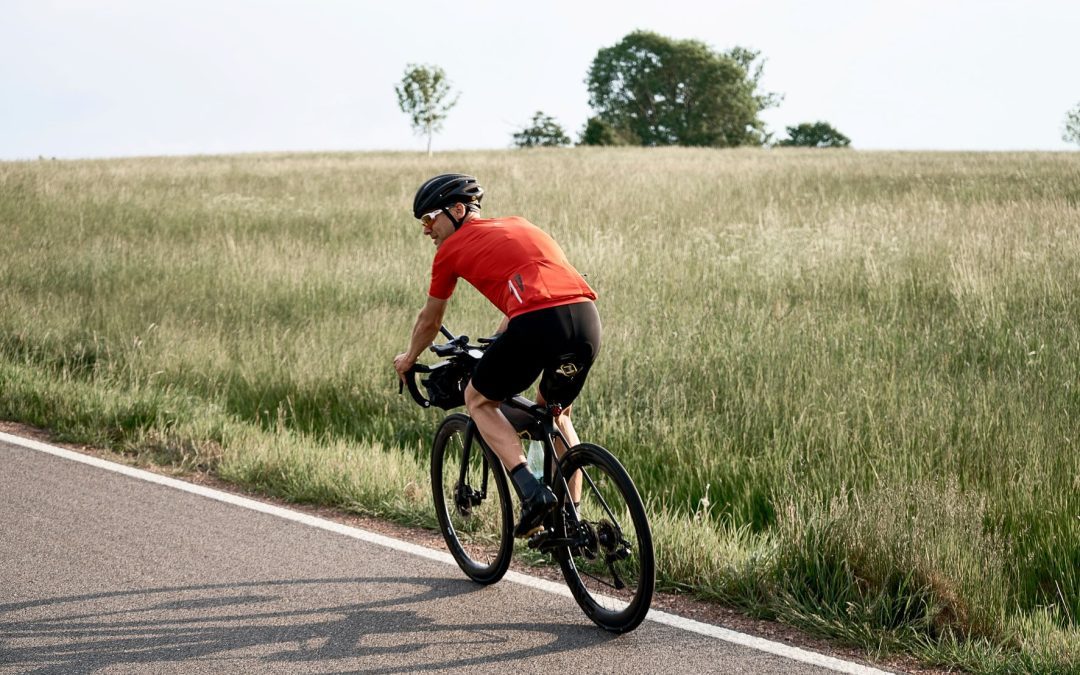
by amie.huiam.net | Nov 23, 2022 | Cycling advice & tips
If you live in a built-up area, or fancy commuting to work by bike, a road bike could be the option for you. From their sleek design, to lighter frames, these kinds of bikes perform very well in urban environments, but which should you buy? Buying a bike can be a bit daunting, but thankfully, you’ve come to the right article. Learn about what you should be looking out for when in the market to buy a brand-new road bike, and some other very handy tips to know before your purchase.
Essential characteristics of a road bike
Every category of bike has something unique for what they’re trying to accomplish. Mountain bikes have a sturdy frame and wider tyres, for example – but what is desirable in a road bike is actually quite different in comparison.
Speed
These kinds of bikes are built with swiftness in mind. The larger wheel sizing and narrow tyres are great at cutting through the air, reducing drag and improving aerodynamics. Think of a road bike like wearing a pair of running shoes, designed with speed in mind, not so much for running over unstable terrain (we’ll talk about road bikes that can do this later on).
Lightweight
Since their performance is designed for riding on hard, smooth surfaces (like roads and paths), some durability can be sacrificed with a lighter frame. This doesn’t mean that your road bike will easily break, of course not, just that there’s less chance of going through rough patches that could put strain on the frame. Since you likely won’t be climbing mountains on a road bike, it means that your bike is a lot lighter. And as you know, less mass to pedal means the faster you can go.
Efficiency
The emphasis on speed and reducing the weight of the machine as much as possible means that your road bike is rather efficient. Every component is designed to make your ride as smooth as possible, from the wheels, to the frame encouraging you to sit in a forward-leaning position. You’ll lean into the wind, rather than your body causing more resistance sitting upright. These tiny details and adjustments culminate into one and result in a bike which is built to get you to and from in the quickest time in flat environments.
‘Perfect road bike’ checklist
1. Group sets
If you’re unfamiliar with what a group set is, it’s simply the name for both the brakes and gears.
Brakes
Like anything you buy, the more you spend the better quality you’ll get – and your group set is no different. Higher end models might come with disk brakes, which work better in wet conditions and are great when cycling on hills. However, this doesn’t mean to say that rim brakes don’t do a good job (many races have been won without using disk brakes, so they’re not an inferior product).
Gears
Better quality gears also mean that shifting up and down whilst riding is easier. You have more choice in gears and also larger cogs in the cassette, which are perfect for going up hills if you want to put less strain on your legs.
2. Wheels/tyre size
When purchasing a bike, it’s a good idea to learn as much as you can about the wheels it comes with. If you’re just starting out, you likely won’t be looking to get better ones until you’ve gotten into the sport more, meaning you’ll want to have the best standard tyres possible whilst your passion grows.
Spokes/inner wheel support
So that you know you’re getting a strong set of wheels, it’s a good idea to observe how many spokes they have. Their strength is determined by the support inside the wheel, so knowing this will ensure your wheels can last for as long as possible.
Tyre width
To increase speed efficiency, you’ll want to look for a bike that comes with quite narrow tyres. To reduce air resistance and make your rides as smooth as possible, try to look for a bike which has a wheel tyre width between 25mm – 28mm.
Tyre frame clearance
Lastly, if you plan on going a bit more off-road with your road bike, then you’ll want to make an effort to find the tyre clearance of the frame. Opting for a frame that is a bit wider in this department can make swapping out your road wheels for something more adventurous easier.
3. Saddle
Unlike other kinds of bikes, the saddle equipped with a road bike is not cushioned. This means that if you’re riding into work without padded shorts, then you’ll most likely have to endure the working week with a sore bum.
Saddles are easily swappable, and you might find that doing some shopping around is needed to make your ride as comfortable as you like. You could easily replace the default one for a very well cushioned seat instead (hopefully you’re commute won’t be as painful if you do)
4. Pedals
This can be a bit of a surprise to first time buyers, but most road bikes actually don’t come with pedals.
Some lower end models are equipped with flat pedals, but we’d recommend for the mot efficient experience, you invest in clip-in pedals. These make it so much easier to pedal, as clipping in enables you to pull up on the pedals as you cycle along.
5. Suspension
It’s not an essential in road bikes, as you won’t likely be going over any huge dips.
Even if you invest in a gravel bike, you’ll find there isn’t really any suspension either. If you think this is a deal breaker, then perhaps a mountain bike is more your speed.
6. Frame material
If you’ve test ridden some road bikes before, you might have realised that ther material of the frame can actually make quite a difference in its performance.
The most common materials are aluminium, steel and carbon fibre.
Aluminium and Steel
Often found in the lower price point of road bikes, these frames have a high strength to weight ratio. Bikes from around the £250 – £1000 mark often use this for their frames.
Carbon Fibre
Anything from +£1000 is where you’ll begin to see this used in road bike frames. Carbon fibre is a more durable material than the others we’ve mentioned previously, but this does mean you’ll have to spend quite a bit more in comparison.
If you’re between the two, it might be a good compromise to go with an aluminium frame and have a carbon fibre fork, as it reduces the frames weight slightly and can also cause vibrations in the handle bars.
Top Road Bikes for 2023
Ammaco Pace Road Bike
If you’re looking to get into road cycling or need a bike that is handy for commuting, then the Ammaco Pace Road model could be perfect for you.
This model comes equipped with a steel frame and double wall alloy rim wheels, so we’re sure that this bike will serve you for a long time. It is a very good starter and can of course be upgraded with better components as you progress.
Salcano GR001 Sora Gravel Road Bike
A step up from our starter bikes, this Salcano model is a great model for those looking to improve their road cycling. Equipped with high quality Shimano gear sets, and doubled walled wheels, this new addition to your road cycling arsenal is sure to take you to the next level.
Can road bikes be used on other terrains?
Whilst ‘road’ is in their name, they can totally be used off road too. What you’ll want in a road bike which can off-road too is the ability to equip it with chunkier tyres, and also some larger gears.
Adjusting your road bike to better suit terrain that is a bit looser can really spice up your rides and commutes. Making the required change to a road bike, or buying one specially made for both road and gravel will mean you can go faster than a mountain bike on road, and go off road.
How much should I be willing to spend?
It can cost £450 and upwards to get a good road bike that could last you quite a while. You can also invest in better parts as time progresses too, meaning that your bike can develop with you on your road bike journey.
We have a wide variety to suit all budgets, and our dedicated staff in store can help you in making the right decision too.
Are woman’s road bikes much different?
Apart from the obvious size difference, there are a few alterations between a men’s and woman’s road bike. From the saddle being better equipped to seat a woman, to a narrower handlebar, these small adjustments can really make a difference in the quality of ride.
However, this doesn’t mean a woman must have a woman’s bike. Whatever is most comfortable is what you should go for, and there is always the ability to customise your bike for the best experience possible.
How can we help you today?
After reading our guide on road bikes, we hope now that you know what to look out for on the most important components on a road bike. With all this knowledge, you’ll now confidently know what you want out of a road bike, and just how much you’re willing to spend.
If you’d like some extra help in deciding what road bike would be best for you, then feel free to come down to one of our 23 stores throughout the midlands and south of England. Our staff will happily help you pick out a brand-new road bike, ready for you to start riding on straight away, or take a look at our selection of road bikes online.
https://www.youtube.com/watch?v=_T7NTe3uBN4
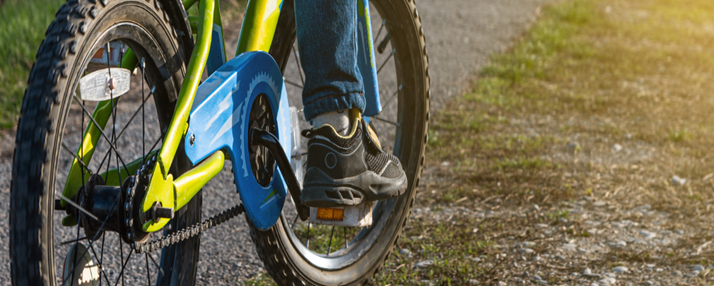
by amie.huiam.net | Oct 26, 2022 | Cycling advice & tips, Kids bikes
We’re sure that you remember learning how to ride your bike for the first time, and now the time has come for you to be the teacher. Before showing them the ways of the bicycle, it’s vital that you ensure they’re safe on their cycling adventures.
In this blog, we’re focusing on 5 tips for keeping your child safe on their first bike. As well as making it safer for them, it’ll also make the process a little less stressful for you.
1. Bike Sizing
The first and most important step to ensuring your child’s safety is finding them the right bike. Don’t buy a bike expecting your child to ‘fit into it’. Ask for help from one of our in-store experts or check out our guide on ‘How to choose the right bike for your child’.
In short, a bicycle is suitable when your child can sit comfortably on the seat, their feet reach the ground, and the handlebars are no higher than their shoulders. You should also consider foot brakes as well as hand brakes to give your child even more protection. Read on to learn more about the correct options for you.
2. Bike options
Your child doesn’t have to go to a bike straight away – we have other bike models on offer that can help develop their confidence on two wheels.
Balance bikes are beneficial for toddlers in developing their coordination and confidence skills. These are very good starters, as it makes it a whole lot easier for your child to progress to a bike since they have developed their balance already.
Tricycle
Great for boosting children’s independence, and for people with disabilities. They are more stable than a standard bike, with the frame closer to the ground, making gathering momentum much easier.
Training wheels
We advise keeping stabilisers on for as long as it takes your child to feel comfortable when riding their bike. This will take time so be patient!
3. Brakes
One of the most important parts of learning to ride a bike is when and how to use the brakes. Our range of kids’ bikes come with brakes that are specially designed for their smaller hands. Here is a breakdown of the types of brakes we offer for children learning on their first bike:
Coaster brakes
Also known as back-pedal brakes or foot brakes, coaster brakes are on most kids’ bikes. They are simple in design and require zero maintenance. However, when they’re removed, they cannot be replaced.
Coaster brakes are most suitable when your child:
- Is familiar with coaster brakes from previous bikes.
- Has a disability that will make hand brakes difficult to use.
–
Hand brakes
Much like what is on a standard adults’ bike, they’re useful when your child:
- Has proven coordination skills, strength and confidence when riding a bike.
- Have used hand brakes with a previous balance bike and are confident enough to use with their first pedal bike.
- Is confident when pedalling and looking to progress.
Whatever the final verdict, make sure your child is comfortable with braking before they take to the road.
4. Rules of the road
Before any trip out, check your child knows the rules of the road and ensure your child is accompanied by a family member. This can bring many further benefits to help your child fall in love with the outdoors. Want to explore more? Click here for some great ideas for cycling with your kids.
You should also ensure all bikes are well-maintained before hitting the road to avoid any accidents or embarrassing calls to friends and family!
5. Equipment
Lastly, but certainly not least, consider the other equipment your child needs.
These are important in helping your child gain confidence before going onto 2 wheels. Plenty of our kids’ bikes come pre-equipped with these, but you can also buy them individually should your kid need a pair.
If they’re still a bit uneasy but are ready to progress from stabilisers, then a parent handle could be a good option. This gives you a bit more control of their cycling efforts without stabilisers supporting them constantly. Parent handles provide a good balance of support and independence that are sure to help your child develop their confidence.
A child should never be without head protection when riding a bike. Ensure that the helmet selected fits their head correctly, as one which is loose or in the wrong position won’t provide all the benefits a helmet gives.
Hi-vis vests are a good idea to equip your child with, especially if your child is beginning to ride on the main road. Make sure they’re visible to all road users, as this will help in preventing any accidents which could potentially occur.
In case they need to make themselves aware of to other road users, like on a busy road, then investing in a bell and horn could be a good idea. We have quite a range, some being more practical and others more playful, but nonetheless do a good job.
You can always trust our in-store team to offer you advice or alternatively, take a look at Cycling UK for a complete list of bike riding essentials. You can also search through our vast array of equipment across our website and in-store.
Hopefully you’re now feeling confident to take the leap on your child’s new adventure with a brand new boys’ or girls’ bike. Our team are more than happy to provide additional advice to meet your needs. Let their cycling journey begin!


























